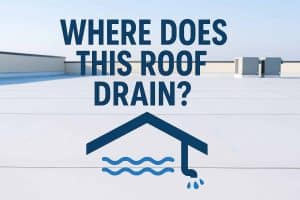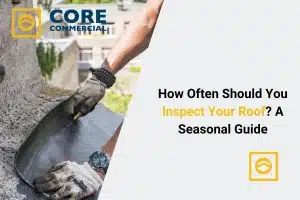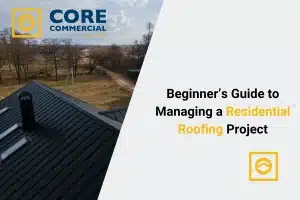Commercial roofs are among the most critical components of any building, protecting everything inside from rain, wind, and extreme temperatures. Yet, because they sit out of sight, they are often out of mind until a leak or drainage issue appears inside. The truth is, most roofing problems don’t start big. They begin with small cracks, clogged drains, or loose flashing.
Among all the preventive steps you can take, keeping drains and gutters clear year-round is one of the most effective and easiest ways to avoid expensive water damage. Pairing that habit with regular inspections and seasonal walk-throughs can add years to your roof’s lifespan. If you want to save money, reduce stress, and keep your business running smoothly, these five do-it-yourself roof maintenance tips are practical steps you can start today. Read on to learn how to protect your investment and stay ahead of costly repairs.

Table of Contents
Why Consistent Commercial Roof Maintenance Matters
A commercial roof may look like a simple flat surface, but it’s actually a system designed to handle water, weight, and weather over many years. Flat and low-slope roofs don’t naturally shed water like steep residential roofs. That makes them more vulnerable to ponding, clogged drains, and punctures from debris.
When neglected, even small roofing issues can snowball into major problems that affect not just the roof but also the business operations beneath it. Water damage is especially dangerous because it can spread invisibly through insulation, walls, and electrical systems before you notice it.
Consequences of ignoring maintenance include:
- Ceiling stains and interior leaks that disrupt workspaces.
- Weakened insulation and structural supports from trapped moisture.
- Mold growth can threaten indoor air quality and employee health.
- Electrical hazards occur when water makes contact with wiring or outlets.
- Emergency repairs that force unexpected closures and big expenses.
By contrast, routine maintenance flips the script. When you set aside a little time for roof care, you stay in control of outcomes. You extend the lifespan of your roofing materials, protect your warranty, improve your insurance claim readiness, and maintain property value. Ultimately, maintenance isn’t just about avoiding leaks. It’s about creating a safer, more predictable business environment.
Tip 1: Perform Roof Inspections After Every Storm
Storms are the most common cause of sudden roof damage. High winds can lift flashing, hail can puncture membranes, and heavy rain can overwhelm drains. Sometimes the signs are obvious, like fallen tree limbs or water seeping into the building. Other times, the damage is subtle, hidden in a seam or beneath pooled water.
After each major storm, check for:
- Tears, blisters, or punctures in the roofing membrane.
- Standing water that lingers more than 48 hours.
- Loose or missing flashing around the roof’s edges, HVAC units, or vents.
- Displaced gravel or protective surface material.
- Cracks are forming near skylights, pipes, or mechanical equipment.
- Debris such as branches, metal, or trash is left on the roof surface.
Even if the inside of your building looks fine, don’t assume the roof escaped unscathed. Many leaks develop slowly over time. A small puncture can allow moisture to creep into layers below, weakening insulation and supports until it becomes a bigger problem.
Safety while inspecting:
Only climb onto the roof when it’s completely dry and safe. Use fall protection gear if required by building code or property height. Bring a flashlight for shaded areas and a phone or camera to document what you find. If climbing isn’t an option, binoculars from the ground or a drone inspection service are safer alternatives.
Pro Tip: Maintain a photo log of all storm inspections. Over time, this creates a history of your roof’s condition, which can be invaluable when filing insurance claims or working with roofing contractors.
Tip 2: Keep Gutters and Drains Clear Year-Round
Of all the DIY steps you can take, keeping your drainage system clean is the simplest yet most powerful. Flat roofs rely on scuppers, gutters, and internal drains to move water off the surface. When those are clogged, water has nowhere to go. It collects, weighs down the structure, and eventually seeps through the roof layers.
Maintenance tasks for drains and gutters:
- Clear out leaves, dirt, trash, and roofing gravel at least four times per year.
- Flush drains with a garden hose to confirm water flows freely.
- Inspect downspouts for rust, cracks, or disconnections.
- Check scuppers for blockage or signs of overflow after rain.
- Remove plant growth, which indicates moisture and debris buildup.
Blocked drainage is a leading cause of roof collapses during heavy storms. The weight of just a few inches of water can add thousands of pounds of stress to the roof deck. By dedicating an hour every few months to cleaning, you can avoid emergency calls and expensive structural repairs.
If your building is surrounded by trees, increase cleaning frequency. Fall is especially critical, as leaves tend to clog drainage systems quickly.
Tip 3: Inspect Seams, Vents, and Flashing for Wear
Every roof has weak points where water is most likely to enter. These include seams between roofing materials, penetrations like vents and pipes, and flashing that seals edges and joints. Over time, exposure to heat, cold, wind, and moisture causes these areas to expand, contract, and eventually fail.
What to look for during inspection:
- Cracks or gaps in sealant around vents and skylights.
- Loose or lifted seams in membranes such as TPO or EPDM.
- Brittle or shrunken caulking that no longer flexes with weather changes.
- Detected or missing flashing that should cover joints and edges.
DIY fixes you can handle:
- Reapply roofing-grade sealant to small cracks or gaps.
- Tighten loose screws on metal flashing.
- Replace worn gaskets or boots on pipes.
If you discover larger tears, sagging sections, or multiple failed seams, it’s best to bring in a professional roofer. Tackling minor issues on your own saves money, but knowing when to stop is equally important for preventing further damage.
Tip 4: Control Tree Growth and Keep the Roof Surface Clean
Trees around a commercial property add shade and curb appeal, but they also create risks. Overhanging branches can scrape membranes during windstorms, while falling limbs can puncture the roof. Leaves, pine needles, and other organic debris hold moisture against the roofing surface, accelerating wear.
Steps to manage trees and surface debris:
- Trim branches so they don’t extend over the roof.
- Sweep or blow off leaves, twigs, and pine needles monthly.
- Remove moss, algae, or lichen using safe cleaning solutions.
- Watch for signs of nests from birds, rodents, or insects.
A clean roof dries faster after rain and makes inspections easier. You’ll be able to see small cracks, blisters, or holes that would otherwise be hidden under piles of debris.
Think of cleanliness as preventive medicine. By keeping the surface clear, you’re reducing the conditions that allow rot, mold, or pests to develop.
Tip 5: Build a Seasonal Roof Walk Routine
Beyond storm checks and drain cleanings, every property manager should commit to a seasonal inspection schedule. Spring and fall are the best times to do a comprehensive roof walk, as they follow seasons known for heavy rain, snowmelt, or storms.
Checklist for seasonal roof walks:
- Walk the entire roof and look for blisters, cracks, or punctures.
- Inspect seams, flashing, and joints closely.
- Test all drains and scuppers to ensure proper flow.
- Clear debris, trash, and leftover tools from maintenance crews.
- Document everything with notes and photos.
By making seasonal inspections a habit, you catch slow-developing problems early. It’s a low-cost way to prevent the kind of expensive surprises that often show up when neglected roofs fail under stress.
What to Do If You Find Damage You Can’t Fix
Not every issue is safe or practical to handle yourself. If you encounter:
- Structural sagging or spongy spots underfoot.
- Tears expose insulation or underlying layers.
- Persistent leaks despite patching attempts.
- Strong odors of mold or signs of interior dampness.
It’s time to call in a roofing contractor. Bring your inspection notes and photos to help them diagnose the problem quickly. This preparation can reduce service costs and ensure the repairs are completed correctly the first time.
Final Thoughts: Protecting Your Roof Protects Your Business
Your commercial roof is more than just a cover. It’s part of your business’s foundation. By dedicating time to inspections, cleaning drains, managing tree growth, and walking the roof each season, you extend its lifespan and protect the assets inside.
The benefits are clear:
- Lower repair and replacement costs.
- A safer environment for employees and customers.
- Fewer disruptions to daily operations.
- Greater peace of mind during storms.
Start with the simplest step: clear your drains and gutters. Combine that with inspections after storms and seasonal roof walks, and you’ll stay ahead of the most common roofing problems. Small, consistent actions today build long-term confidence and security for your business tomorrow. Forms, and keep a record of your inspections. These small steps build confidence and help you avoid expensive surprises.
FAQs
How to check a commercial roof after a heavy storm?
Start by looking for pooling water, torn roof membranes, or debris. Check metal flashing around edges and vents. Document anything unusual with photos for future repairs or insurance.
How often should I inspect my commercial flat roof?
Inspect your roof at least twice a year—once in spring and once in fall. Also, check it after big storms. Regular checks help you find small problems before they grow.
Why is ponding water on flat roofs a big problem?
Water that doesn’t drain within 48 hours can cause roof damage. It adds pressure to your roof, causes leaks, and shortens the life of your roof materials.
Can clogged drains damage a commercial roof?
Yes. Blocked drains stop water from leaving the roof. This causes pooling, leaks, and even roof collapse in severe cases. Clean gutters and drains regularly.
What are the signs of commercial roof seam failure?
Look for cracks, lifting seams, bubbling, or gaps near joints. These weak areas allow water to enter. Early sealing can save you from costly repairs later.
Is it safe to inspect a commercial roof by myself?
Yes, if you follow safety rules. Only inspect when the roof is dry. Wear non-slip shoes and use a harness if needed. Use a checklist and take photos during the inspection.
How do I safely clean commercial roof gutters?
Use gloves, a bucket, and a garden hose to remove leaves and debris. Always use a stable ladder or work with a buddy. Flush water through to check for clogs.
Do trees near my building affect my roof?
Yes. Overhanging branches can damage roof surfaces and drop leaves that block drains. Trim them back and clean debris monthly to keep your roof safe.
What should I include in a roof maintenance checklist?
Include steps like checking for leaks, clearing drains, inspecting seams, looking at flashing, and removing debris. A photo log helps track your roof’s condition.
When should I call a professional for roof issues?
If you find major damage like large tears, sagging spots, or repeated leaks, call a commercial roofer. They have the tools and knowledge to handle serious problems safely.






